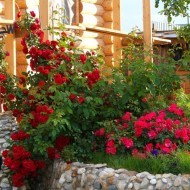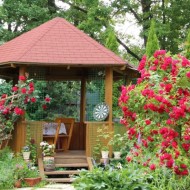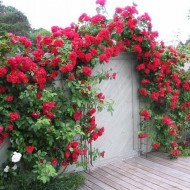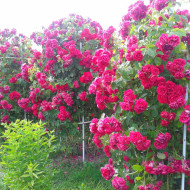All about planting and growing the climbing rose Flamentanz: expert advice
Content
- 1 The history of the Flammentanz cultivar
- 2 Features of the Flamentants variety
- 3 Advantages and disadvantages of the variety
- 4 Video "Growing the Flamement rose in the open field"
- 5 How to grow a rose Flamement in the country
- 6 Dangerous diseases and pests
- 7 The use of the Flamentanz rose in landscape design
- 8 Variety reviews
The history of the Flammentanz cultivar
The history of the climbing rose Flamentanz (also known as the Flammentanz) began in 1952. On the basis of the W. Kordes & Sons gardening nursery, founded by the famous German gardener and breeder Wilhelm Kordes, a selection experiment was carried out to cross the red-brown rosehip Rosa rubiginosa and the hybrid form Rosa x kordesii.
In 1955, at the next exhibition of roses in Germany, a new variety was presented, named Flammentanz. Translated from German, the name of the flower means "dance of flame". In botanical reference books, there are other variety names, among which Flame Dance, Flaming Dance, Korflata and Vlammenspe are considered the most common.
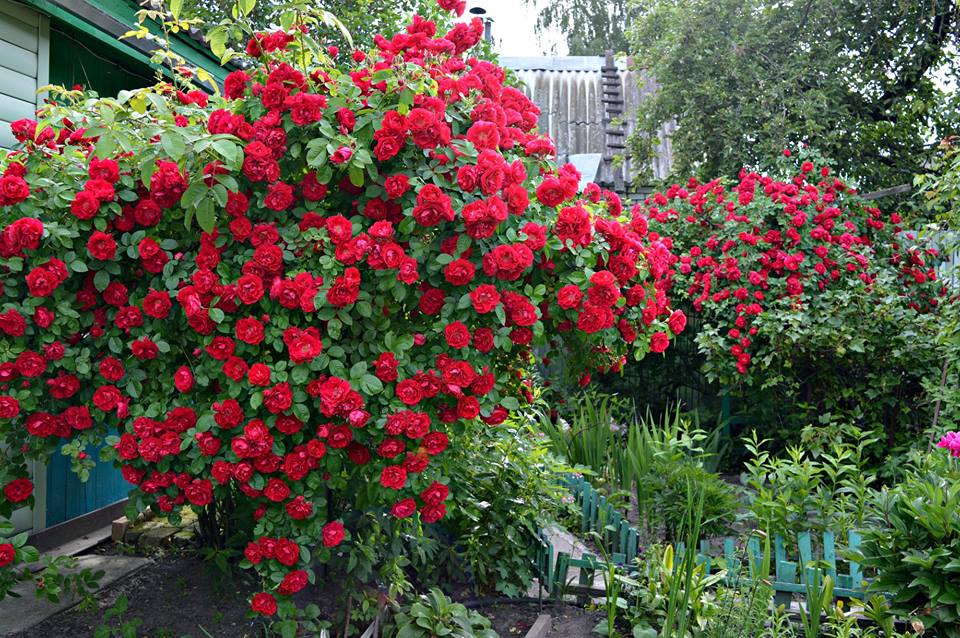
Features of the Flamentants variety
Let's start our acquaintance with the Flamentanz rose from its description. So, the bush is characterized by intensive growth. The height of an adult shrub reaches 2–5 m, the width is at least 2.5 m. The root system is powerful and rapidly developing. The shoots of the variety are strong, resilient, prickly, with wide bases. For its excellent vitality and resistance to adverse weather events, the people called this variety "unkillable rose".
The Flamementz variety is characterized by large leaves of a dark green color. The back surface has a traditional glossy sheen. Leafiness is above average. As a result, the shrub looks spectacular at any stage of the growing season.
Begins to bloom in June-July. If faded buds are removed in time, re-flowering is possible during the season. Rosa Flamentanz blooms profusely. The shrub is covered with large, semi-double buds of raspberry-red color. The diameter of the flower in the opened state reaches 8-10 cm. In one bud, there are from 25 to 40 wavy petals. The peculiarity of the variety is its high resistance to fading.
The buds collected in inflorescences exude a pleasant and unobtrusive aroma. In one inflorescence there are about 5-7 buds. The climbing rose has high decorative characteristics.
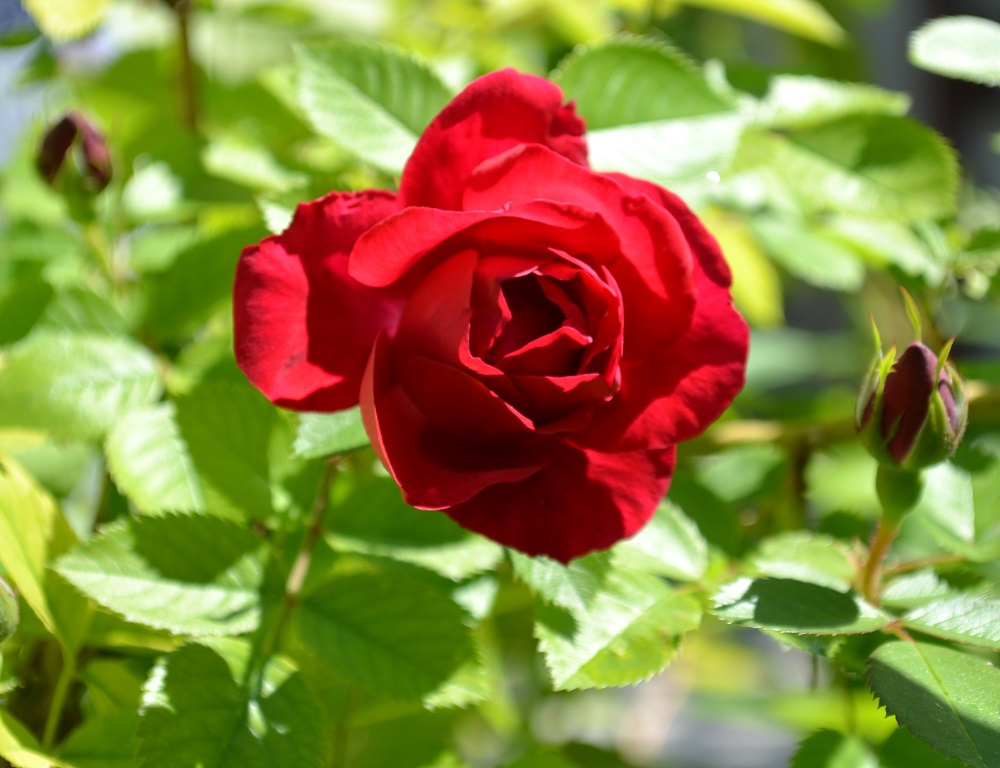
Advantages and disadvantages of the variety
Rose Flammentanz, like any other ornamental crop, has certain positive and negative qualities, which you need to familiarize yourself with before deciding to grow a flower.
- unpretentiousness to growing conditions and care;
- high decorativeness at all stages of the growing season;
- good adaptive abilities;
- bright and rich bloom;
- pleasant, unobtrusive aroma;
- high resistance to invasions of harmful insects and resistance to natural anomalies.
- the need for frequent pruning;
- one (much less often - two) flowering waves.
Video "Growing the Flamement rose in the open field"
This video shows you how to care for a climbing rose in unprotected ground.
How to grow a rose Flamement in the country
The Flamentants variety, being unpretentious in care, can be grown even by novice gardeners. The agrotechnical measures described below will increase the viability of the plant.
Optimal growing conditions
The intensity and duration of flowering of the bush depends on the correctness of the chosen place for planting. The Flamentian is not afraid of active sunlight. The duration of daylight hours should be at least 5-7 hours a day. The presence of shade and even partial shade is negatively reflected on the flowering of the shrub.
Note that the plant reacts negatively to wind, draft, and cold air. For this reason, you should not consider planting options in lowlands and in windy areas.

A breathable and moderately moist soil is required. The proximity of the occurrence of groundwater leads to the development of putrefactive processes on the root processes. Heavy soils clog the plant, preventing it from growing and developing. An ideal substrate for planting and growing is considered to be high-humus loam or chernozem with a high content of the humus layer. The recommended soil acidity is from 6, 5 to 7 pH.
Landing rules
Planting a rose bush in open ground is performed at the end of April or the very beginning of May. It is desirable that the soil warms up to + 10 ... +12 ° C. Autumn planting is possible in regions with warm and mild winters.
Planting holes measuring 50x50 cm are prepared in 7-10 days. First, each well is well moistened, then filled with drainage materials and nutrients. The seedling is placed on a mound formed from sod land, river sand, humus, peat and wood ash. The roots of the seedling are carefully straightened, the root collar is deepened by 3-5 cm.
A rose bush planted in open ground is watered abundantly and mulched with peat mixed with hay. Watering is carried out along the edge of the trunk circle.
Climbing rose care
Caring for the Flamentanz rose involves timely watering, feeding with nutrients, loosening the soil, removing weeds and annual pruning.
Water the plant twice a week. If the leaves are drooping, it is worth increasing the volume of water. So, on average, 10–20 liters of settled water at room temperature is poured under one rose bush. After each watering, shallow loosening of the upper soil layer is carried out. Do not forget about the periodic removal of weeds - weeds breaking through from the ground negatively affect the decorative effect of the bush.
You can feed the decorative culture according to the scheme below:
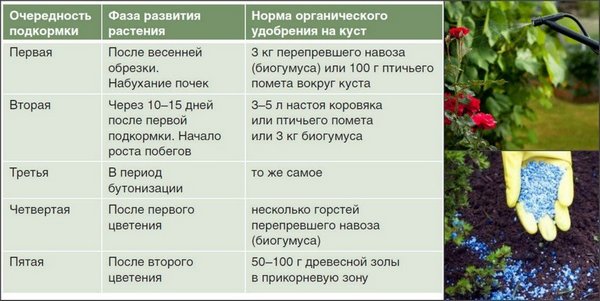
A climbing rose must be pruned. The procedure contributes to the rejuvenation of the shrub, and also allows you to maintain its decorative appearance. A thickened and overgrown rose bush looks unattractive.
From the second year after planting in a permanent place of growth, sanitary and formative pruning is carried out. During the growing season, faded buds, broken and dry branches are removed. In the spring, before the start of the stage of active sap flow, the crown is rejuvenated. Short flowering shoots are shortened to 2-3 buds, long ones are cut in half. Old shoots are removed at the root, leaving only 2-3 of the strongest and healthiest-looking branches.
A climbing rose needs support. Arches, chain-link nets, tripods, stands, pergolas and trellis nets are used as a support for the branches of a rose bush.
The next step in caring for the Flamentanz rose is preparing for winter. At the beginning of autumn, water-charging irrigation is carried out, then the root part of the shrub is abundantly mulched with peat, dry river sand and spruce branches.The branches are removed from the supports, collected in bunches and covered with spunbond or burlap. In the northern regions, the decorative bush is additionally insulated with pine spruce branches.
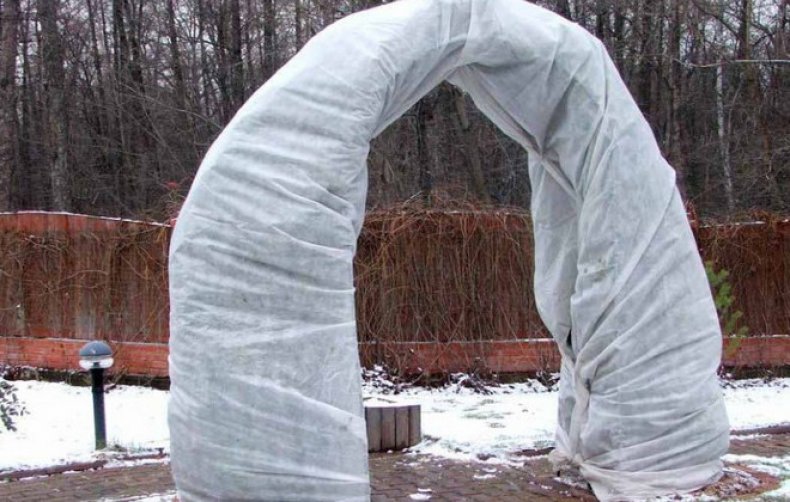
Dangerous diseases and pests
A unique feature of the Flammentanz variety is the absence of damage by harmful insects. Unlike other rose bushes, this variety does not attract pests.
Unfortunately, resistance to infectious diseases is not so perfect. The plant can be affected by black spot and powdery mildew, as evidenced by black spots and / or white bloom on leaves and stems. To protect ornamental shrubs, fungicides "Fundazol", "Horus", "Magnicur Star", "Abiga-Peak", "Skor" and "Topaz" are used.
The use of the Flamentanz rose in landscape design
A climbing rose is an ideal decoration for a personal plot. Flamenants are often used to decorate the walls of garden pavilions and outbuildings. The abundantly flowering plant looks interesting on wrought-iron fences and wooden fences. Decorated with large crimson-red buds, arches and columns will harmoniously fit into any style of landscape.
- Solitary planting near the fence
- Flower bed
- Landscaping of the recreation area in the garden
- Decorating arches
- Wicket and fence decoration
- Vertical gardening of the site
Variety reviews
“It is with great pleasure that I recommend the Flamentanz rose to all novice flower growers. The plant does not require any specific care and annually pleases with abundant flowering. "
“Last year I ran into trouble - a garden rose of the Flamentantz variety got infected with black spot. Fortunately, the disease was identified early. Having applied several treatments of the crown with the Fundazol solution, we were able to save the ornamental bush. "
If you are looking for an unpretentious, but highly decorative shrub for your summer cottage, take a look at the climbing rose of the Flamentants variety.


